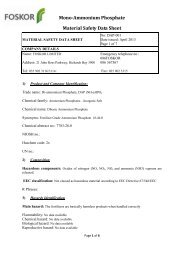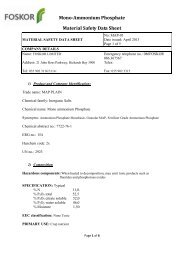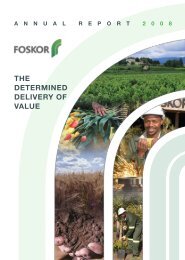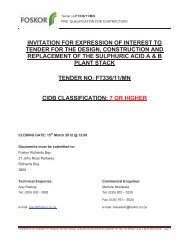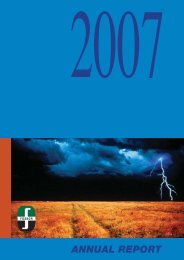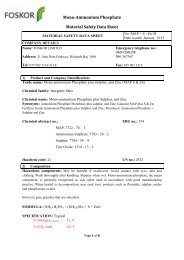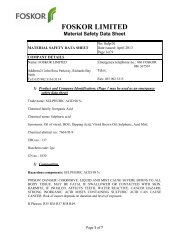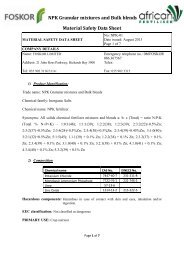Download Annual Report 2006 - Foskor
Download Annual Report 2006 - Foskor
Download Annual Report 2006 - Foskor
You also want an ePaper? Increase the reach of your titles
YUMPU automatically turns print PDFs into web optimized ePapers that Google loves.
PRINCIPAL ACCOUNTING POLICIESAssets held under finance lease agreements are capitalised. Suchassets are depreciated in terms of the accounting policy on property,plant vehicles and equipment stated above. Finance leases arecapitalised at the inception of the lease at the lower of the fair valueof the leased property or the present value of the minimum futurelease payments. Lease finance charges are allocated to accountingperiods over the duration of the leases by the effective rate method,which reflects the extent and cost of the lease finance utilised in eachaccounting period.All other leases are treated as operating leases and the relevantlease payments (net of any incentives received from the lessor) arecharged to income on a straight line basis over the lease term.The Group is the lessorAssets subject to finance lease agreement are treated as receivables.Finance income is allocated to accounting periods over the durationof the leases by the effective interest rate method, which reflects theextent and cost of lease finance income earned in each accountingperiod.All other leases are treated as operating leases and the relevantrental incomes are recognised in income on a straight line basis overthe lease term.8. ORE STOCKPILINGOre stockpiles consist of ore bought from the neighbouring PhalaborwaMining Company and is stockpiled on <strong>Foskor</strong>’s property.Ore stockpiles are valued at the lower of cost and net realisablevalue. Cost includes expenditure incurred in the mining and stockpilingof ore for use in future production.9. INVENTORIESSpares and consumablesSpares and consumable are valued at the lower of cost and netrealisable value, on a weighted average method.The cost of inventories comprises all costs of purchase, conversionand other costs in bringing the inventories to the present locationand condition.Obsolete, redundant and slow moving items of spares and consumablestores are identified on a regular basis and written down to theireconomic or realisable value.Net realisable value is the estimated selling price in the ordinarycourse of business, less the costs of completion and sellingexpenses.Raw materials and finished goodsRaw materials and finished goods consisting of phosphate rock,phosphoric acid and other minerals are valued at the lower of eithercost of production and net realisable value.Cost of production is calculated on a standard cost basis, whichapproximates the actual cost and includes the production overheads.Production overheads are allocated on the basis of normalcapacity.The valuation of inventory held by agents or in transit includesforwarding costs, where applicable.Net realisable value is the estimated selling price in the ordinarycourse of business, less the costs of completion and sellingexpenses.10. TRADE AND OTHER RECEIVABLESTrade receivables are recognised initially at fair value and subsequentlymeasured at amortised cost using the effective interestmethod, less provision for impairment. A provision for impairmentof trade receivables is established when there is objective evidencethat the Group will not be able to collect all amounts due accordingto the original terms of receivables. The amount of the provision isthe difference between the asset’s carrying amount and the presentvalue of estimated future cash flows, discounted at the effective interestrate. The amount of the provision is recognised in the incomestatement.11. PROVISIONSA provision is recognised when it is probable that the Group willsettle an existing legal or constructive obligation from past eventsresulting in an outflow of resources embodying economic benefits,and when a reliable estimate of the obligation can be made. Wherethe effects of discounting are material, provisions are measured attheir present values.Staff costs in respect of annual and long service leave are accruedfor in the period in which services were rendered by employees.12. PENSION LIABILITYThe Group operates a defined benefit and contribution plan, the assetsof which are held in separate trustee-administered funds. Theschemes are generally funded through payments to insurance companiesor trustee-administered funds as determined by periodic actuarialvaluations. A defined benefit plan is a pension plan that definesan amount of pension benefit to be provided, usually as a function ofone or more factors such as age, years of service or compensation.A defined contribution plan is a pension plan under which the Grouppays fixed contributions into a separate entity (a fund) and will haveno legal or constructive obligations to pay further contributions ifthe fund does not hold sufficient assets to pay all employees benefitsrelating to employee service in the current and previous periods.The liability in respect of defined benefit pension plans is the presentvalue of the defined benefit obligation at the balance sheet dateminus the fair value of plan assets, together with adjustments foractuarial gains/losses and past service cost. The defined benefit obligationis calculated once every three years by independent actuariesusing the projected unit credit method. The present value of thedefined benefit obligation is determined by the estimated future cashoutflows using interest rates of government securities which haveterms to maturity approximating the terms of the related liability.Actuarial gains and losses arising from experience adjustments andthe effects of changes in actuarial assumptions to the defined benefitplans are recognised fully in income statement in the current year.Past-service costs are recognised immediately in income, unless thechanges to pension plan are conditional on the employees remainingin service for a specified period of time (the vesting period). In thiscase, the past-service costs are amortised on a straight-line basisover the vesting period.For defined contribution plans, the company pays contributions topublicly or privately administered pension insurance plans on a mandatory,contractual or voluntary basis. Once the contributions havebeen paid, the company has no further payment obligations. Theregular contributions constitute net periodic costs for the year inwhich they are due and as such are included in staff costs.13. OTHER POST-EMPLOYMENT LIABILITYThe Group provides post-employment healthcare benefits to its retireeswho were employed by the company on or before 1 July 1995.The same benefits are provided to a specific group of employeesemployed before 1 July 1996. The entitlement to post-employmenthealth care benefits is based on the employee remaining in service upto retirement age. The expected costs of these benefits are accruedover the period of employment, using the projected unit of credit26



